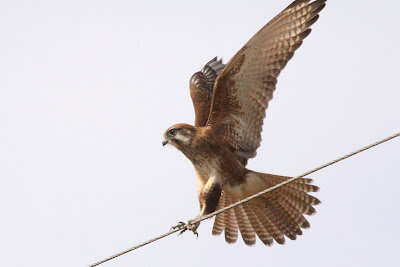
We left our camp by sunup, and stopped for breakfast at Cobar, right on the edge of town where a small dam offered a range of birds. Whiteface and babblers shared a treestump, cockatoos and corellas screeched in to drink. Dozens of martins circled us.
Just past Wilcannia we came across a flock of more than 200 Red-tailed Black Cockatoos feeding on the ground beside the road. They apparently change food sources depending on the seasons, feeding on Sheoak seeds, White Cedar fruits or the seeds of weeds such as Storksbill and Cathead.
And then on to Broken Hill and the Desert Park. An amazing place - the Living Desert Sculptures on top of the ridge were spectacular in the late afternoon light, and the bird and animal life could have kept us occupied for hours.
Bird list:
Chirruping Wedgebill (pictured above)
Yellow-throated Miner
White-backed Swallow
White-winged fairywren
Singing Honeyeater
Spiny-cheeked Honeyeater
Orange-breasted Chat
Tree Martin
Southern Whiteface (Pictured above)
White-browed Babbler
Pied Butcherbird
Apostlebird
Australian Raven
Galah
White-winged Chough
Ringnecked Parrot
Sulphur-crested Cockatoo
Major Mitchell Cockatoo
Black-fronted Dotterel
Blue-faced Honeyeater
Crested Pigeon
Little Corella
Willie Wagtail
Emu
Red-winged Parrot
Australian Pipit
Australian Kestrel
Red-tailed Black Cockatoo
Black Kite
European Starling































